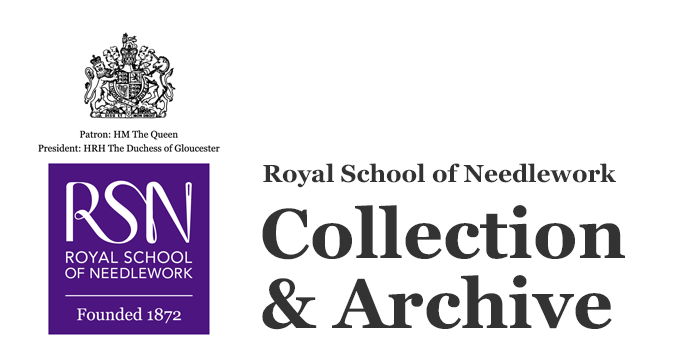Sampler
Object name
Date made
Circa 1630-1650
Place made
Description
Early 17th-century spot sampler worked in silk and metal threads on unbleached linen.
Content description
Rectangular spot sampler stitched on unbleached linen with silk and metal threads. The sampler features five diaper motifs outlined in green and blue silk thread with a back stitch and partially filled in with green, pink, yellow, and blue tent stitches. These motifs are acorns and oak leaves, stylised carnations, a strawberry, roses and borages or cornflower, and fleurs de lis. The motifs are embellished with woven wheels and Elizabethan plaited braid, stem, and chain stitches in gold and silver passing thread. In the top right corner are several lines of braiding stitches worked in silver passing thread.
There is a patch on one corner made from a similar ground fabric in a different orientation, so that its warp is perpendicular to the warp on the rest of the object, and possibly stitched in a different hand. This patch has been slip stitched on with modern bleached thread.
This is a typical spot sampler. Spot samplers were worked in England from the early decades of the 17th century and seem to have been most commonly produced in the first half of the century, though they were still made in the latter half. They feature standalone motifs that are stitched in a seemingly random fashion across a ground fabric, usually linen. These samplers are rarely initialled, signed, or dated, suggesting that they were made as personal stitch references rather than for display. This theory is buttressed by the fact that many spot samplers, including this one, feature motifs that are partially worked. This spot sampler includes floral and geometric repeating patterns that would have been used to decorate objects like bags, cushions, or other domestic furnishings. It is thought to be the oldest sampler in the RSN collection.
There is a patch on one corner made from a similar ground fabric in a different orientation, so that its warp is perpendicular to the warp on the rest of the object, and possibly stitched in a different hand. This patch has been slip stitched on with modern bleached thread.
This is a typical spot sampler. Spot samplers were worked in England from the early decades of the 17th century and seem to have been most commonly produced in the first half of the century, though they were still made in the latter half. They feature standalone motifs that are stitched in a seemingly random fashion across a ground fabric, usually linen. These samplers are rarely initialled, signed, or dated, suggesting that they were made as personal stitch references rather than for display. This theory is buttressed by the fact that many spot samplers, including this one, feature motifs that are partially worked. This spot sampler includes floral and geometric repeating patterns that would have been used to decorate objects like bags, cushions, or other domestic furnishings. It is thought to be the oldest sampler in the RSN collection.
Dimensions
width: 22cm
height: 12cm
height: 12cm
Materials
Stitches
Techniques
Motifs
Catalogue number
COL.10
Other numbers
RSN 215
© Royal School of Needlework

